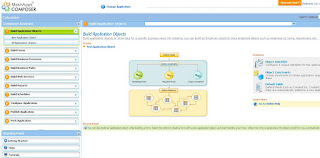Introduction
Cloud is one of the buzzwords today and Cordys also has a Cloud platform: The Cordys Process Factory (CPF).So what is it?
It is a webbased integrated cloud environment for rapid Cloud Application Development. You can build forms, business processes, integration with other webservices and reporting.
How does it work?
A CPF Composer is used to design forms, business processes, business rules, using external webservices, reports and charts (PDF, HTML, MS Word, or MS Excel).
SaaS
There is a CPF marketplace where you can sell your cloud application as a SaaS product and where you can buy other products as well.
A Simple example
When you fill in you credentials the Cordys Explorer or MashupComposer is shown.* Select "Create a new application" and fill in the application information, click Save and go to Composer
* The Composer is shown
* Select Build Forms > New Form and fill in the following details
* The Forms composer is shown. Drag-and-Drop a Number field and fill in the properties
* Add Another Number2 field
* Add another Sum (Number field) with the following properties:
* Click Save
* Click Check In. This way other users can use it.
Create Application Tab and Add Form to it
* Click Configure Application > Application Tabs
* Click Check Out (in order to make changes to it)
* Click New Tab and fill in Properties and click OK
The Tab is added to the existing Tabs
* Click Save and click Check In
Publish the Application
Now we are ready to Publish the application* Click Publish Applications on the Composer Assistant
Use the Calculator Application
Now we can use the calculator application* Click Change Application and you can select the Calculator App
* Click the Calculator Tab and fill in some numbers
Notice that the numbers are automatically added.
Conclusion
This blog item showed the possibilities of the Cordys Process Factory Cloud Platform with which you can develop Cloud Mashup Applications.
More information can be found here and you can register here to start developing cloud applications.













Reacties
Een reactie posten